Vinyl’s making a comeback, baby! But let me tell you, diving into the world of record players can be as confusing as trying to untangle a pair of earbuds that’s been in your pocket all day. Trust me, I’ve been there!
One question that keeps popping up, especially for newbies, is whether record players need speakers. It’s a fair question – I mean, how are you supposed to hear those sweet, sweet tunes if there’s no sound coming out, right?
Well, buckle up, vinyl lovers, because we’re about to embark on a groovy journey through the world of turntable audio setups.
We’ll explore everything from all-in-one systems to fancy external speaker setups that’ll make your ears dance with joy.
Whether you’re a vinyl veteran or just dipping your toes into the wonderful world of records, this guide’s got you covered.
So, drop that needle, crank up the volume (but not too loud – we don’t want any noise complaints!), and let’s dive in!
Do Record Players Need Speakers? What to Know
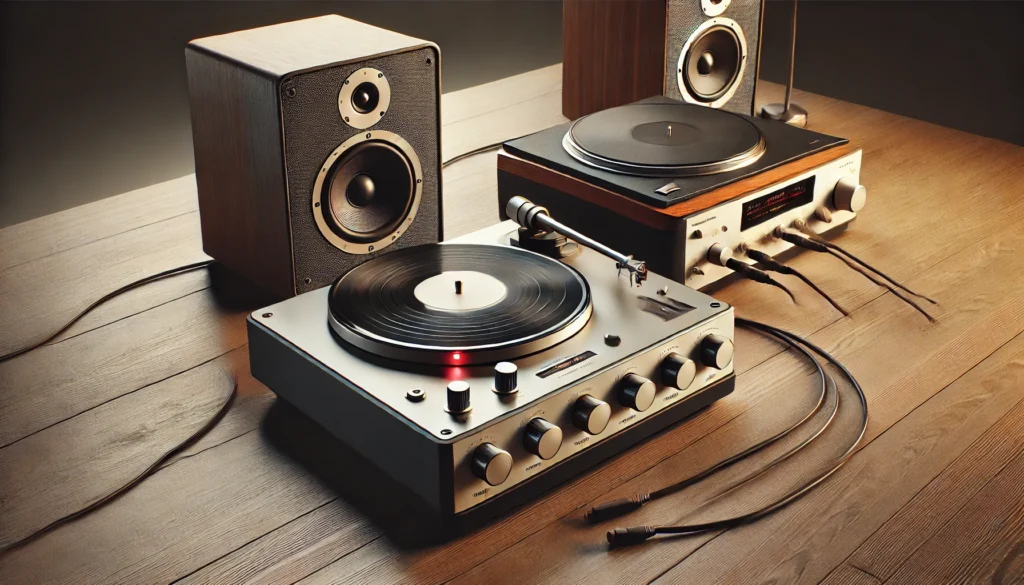
Most record players don’t have built-in speakers and require external speakers or an audio system to produce sound.
However, some all-in-one turntables come with integrated speakers. The quality and volume of built-in speakers are usually limited, so many vinyl enthusiasts prefer separate speakers for better sound quality.
We’ll dive deeper into the world of record players and speakers below, but that’s the quick answer for those of you in a hurry!
Types of Record Players and Their Speaker Setups
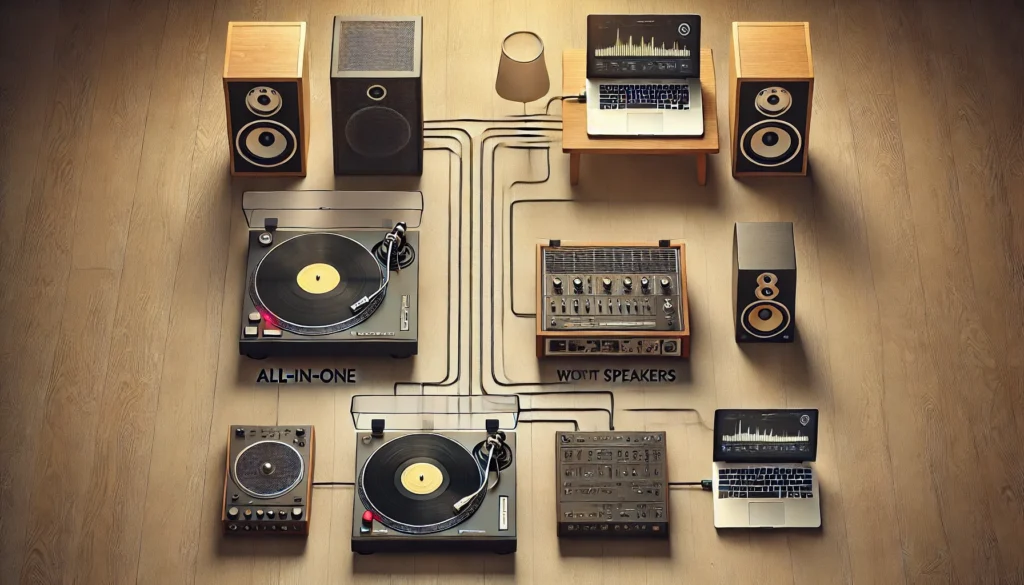
Alright, let’s dive into the world of record players and their speaker setups! I remember when I first got into vinyl, I was so confused about all the different types of turntables out there.
But don’t worry, I’ve made all the mistakes so you don’t have to!
First up, we’ve got all-in-one record players with built-in speakers. These babies are like the Swiss Army knives of the vinyl world.
They’re super convenient, especially if you’re just starting out or don’t have much space. I had one of these in college, and let me tell you, it was a lifesaver in my tiny dorm room!
But here’s the thing – while they’re great for beginners, the sound quality can be a bit… meh. It’s like listening to your favorite song through a tin can sometimes. But hey, we all gotta start somewhere, right?
Next, we’ve got traditional turntables without built-in speakers. These are the ones you’ll see in those fancy hi-fi setups that make you drool.
They don’t have speakers, but man, the sound quality can be out of this world! Of course, that means you’ll need to connect them to external speakers or an audio system.
I remember the first time I heard a proper turntable setup at my uncle’s place. It was like hearing music for the first time all over again! But fair warning – once you go down this rabbit hole, your wallet might start crying.
Lastly, we’ve got USB turntables. These are pretty cool because they let you convert your vinyl to digital files. It’s like a time machine for your music!
I use one of these to digitize some of my rarer records that I’m afraid to play too often.
So there you have it – the three main types of record players. Each has its pros and cons, and trust me, I’ve been through the ringer with all of them.
But that’s half the fun of getting into vinyl, right? The journey of figuring out what works best for you!
Components Needed for a Complete Turntable System
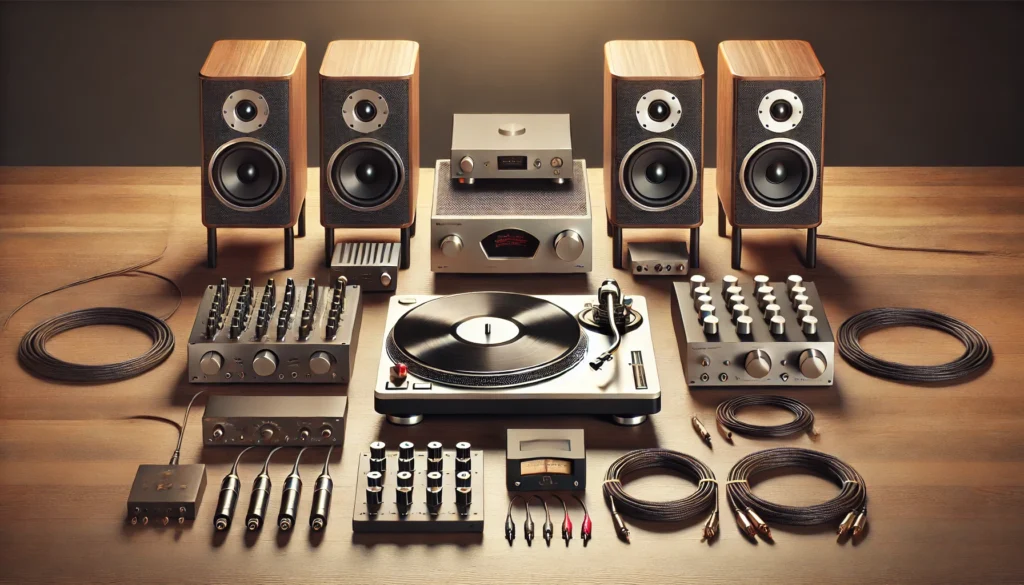
Okay, folks, let’s talk about the components you need for a kickass turntable system. I’m gonna break it down for you, just like I wish someone had done for me when I was starting out.
First up, obviously, you need a turntable. That’s the thing that actually spins your records. Seems simple enough, right?
Well, I once bought a turntable at a garage sale, thinking I’d scored a great deal. Turns out, it was missing half the parts. Lesson learned: make sure your turntable is complete!
Next, you’re gonna need a phono preamp. This little gadget is super important because it boosts the signal from your turntable to a level that your amplifier can work with.
Some turntables have these built-in, but if yours doesn’t, you’ll need a separate one. I once tried to skip this step and… let’s just say it wasn’t pretty.
Then there’s the amplifier or receiver. This bad boy takes the signal from your phono preamp and makes it powerful enough to drive your speakers.
I remember the first time I hooked everything up correctly and cranked up the volume – my neighbors weren’t too happy, but man, it felt good!
Of course, you can’t forget the speakers. These are what actually produce the sound you hear. You’ve got a ton of options here, from small bookshelf speakers to massive floor-standers.
I started with some hand-me-down speakers from my dad, and let me tell you, even those old things sounded amazing compared to my previous setup.
Last but not least, you’ll need cables and connections to hook everything together. Don’t skimp on these! I learned the hard way that cheap cables can really mess with your sound quality.
It’s like trying to drink a milkshake through a coffee stirrer – it just doesn’t work well.
So there you have it – the basic components of a turntable system. It might seem like a lot, but trust me, once you get it all set up, you’ll be in vinyl heaven.
And hey, if you mess up along the way, don’t sweat it. We’ve all been there!
Pros and Cons of Built-in Speakers vs. External Speakers
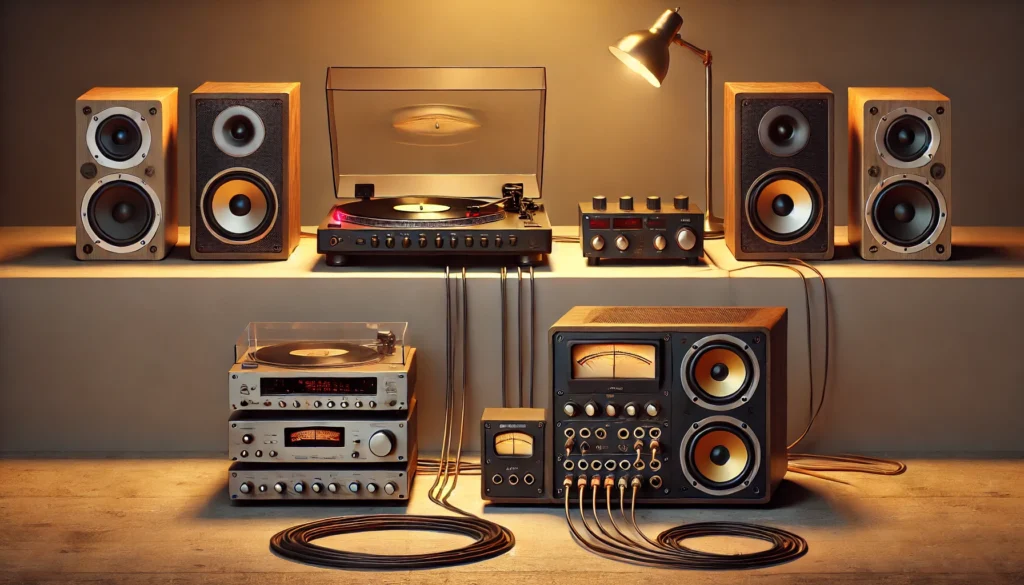
Alright, let’s get into the nitty-gritty of built-in speakers versus external speakers. This is a debate that’s been raging in the vinyl community for years, and I’ve been on both sides of it!
Let’s start with the all-in-one systems that have built-in speakers. The big advantage here is convenience. Everything’s in one package – you just plug it in and you’re ready to rock. I remember when I got my first all-in-one player. I was so excited, I had it up and running in like 5 minutes flat!
These systems are also usually more affordable and take up less space. If you’re living in a shoebox apartment like I was in my 20s, this can be a real lifesaver. Plus, they’re super portable. I used to bring mine to parties all the time – instant cool points!
But here’s the rub – the sound quality on these built-in speakers often leaves a lot to be desired. It’s like trying to get a gourmet meal from a vending machine. Sure, it’ll do in a pinch, but it’s not gonna blow your mind.
Now, let’s talk about separate speakers. The biggest advantage here is sound quality. Oh man, the first time I heard my records through a proper set of external speakers, it was like I was hearing them for the first time all over again! The clarity, the depth, the soundstage – it was mind-blowing.
External speakers also give you way more flexibility. You can upgrade your speakers without changing your whole system, experiment with different placements, and really customize your sound. It’s like being the conductor of your own orchestra!
But of course, there are downsides. Separate speakers take up more space, they’re usually more expensive, and setting everything up can be a bit of a hassle. I remember spending an entire weekend trying to get my first proper system set up. There may have been some frustration and colorful language involved…
And let’s not forget about all the extra cables. If you’re not careful, your listening area can start to look like a spaghetti factory exploded in there.
In terms of sound quality comparisons, it’s usually no contest. External speakers almost always sound better. But that doesn’t mean built-in speakers don’t have their place. It all depends on your needs, your space, and your budget.
Speaking of budget, that’s definitely a consideration. You can spend anywhere from a hundred bucks to the price of a small car on a speaker setup. I’ve been down both roads, and let me tell you, sometimes less is more!
At the end of the day, it’s all about what works for you. Whether you’re rocking built-in speakers or a fancy external setup, the most important thing is that you’re enjoying your music. That’s what it’s all about, right?
How to Choose the Right Speakers for Your Record Player
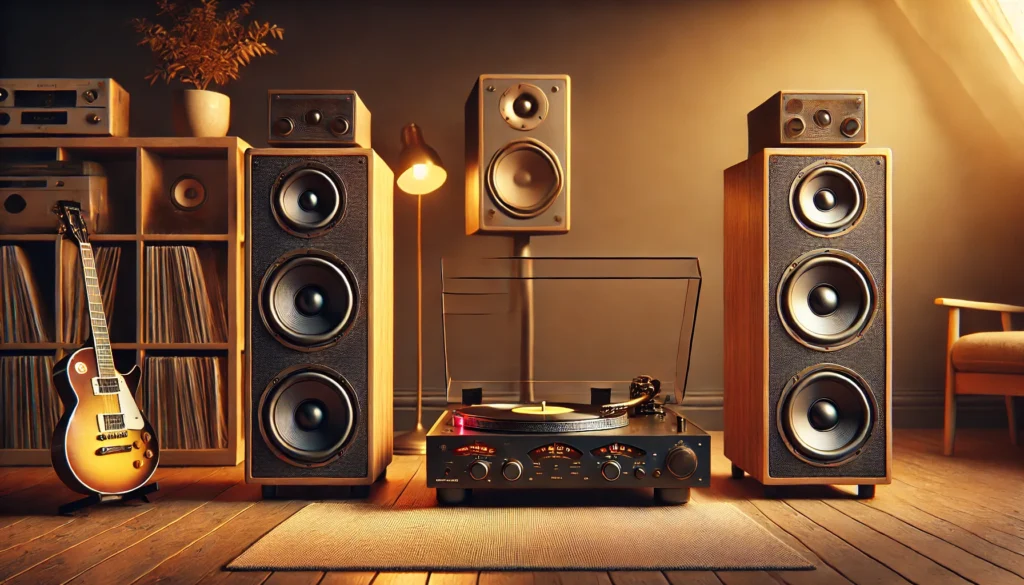
Alright, folks, let’s talk about choosing speakers for your record player. This can be a real head-scratcher, but don’t worry – I’ve been through this process more times than I care to admit, and I’m here to help you avoid some of the mistakes I made.
First up, you’ve gotta decide between active and passive speakers. Active speakers have built-in amplifiers, while passive speakers need a separate amp. I started with passive speakers because that’s what my dad used, but let me tell you, when I switched to active speakers, it was like a whole new world opened up! No more fiddling with a separate amp, and the sound was perfectly matched to the speakers.
Next, you need to think about size and power. Now, I know it’s tempting to go for the biggest, baddest speakers you can find. Trust me, I’ve been there. But bigger isn’t always better. I once crammed a pair of massive floor-standers into my tiny apartment. They sounded great, but I could barely move around the room!
You need to consider the size of your space and how loud you actually need your music to be. For most people, a good pair of bookshelf speakers will do the trick. They’re compact, they sound great, and they won’t get you evicted from your apartment. Ask me how I know…
Compatibility is another big factor. Make sure your speakers will play nice with your turntable and other components. I once bought a pair of speakers only to find out they weren’t compatible with my amp. Talk about a facepalm moment!
And of course, we can’t forget about budget. Speakers can range from dirt cheap to “sell a kidney” expensive. My advice? Start with something in the middle range. You don’t need to break the bank to get good sound, but you also don’t want to go too cheap and end up with speakers that sound like they’re underwater.
I remember saving up for months to buy my first “real” pair of speakers. When I finally got them home and set them up, it was like hearing my records for the first time all over again. The clarity, the depth, the way I could hear every little detail – it was mind-blowing!
But here’s the thing – what sounds good to me might not sound good to you. Everyone’s ears are different. So if you can, try to listen to speakers before you buy them. Most hi-fi shops will let you demo speakers, and some online retailers have good return policies.
And don’t be afraid to experiment! Half the fun of this hobby is trying different setups and seeing what works best for you. I’ve gone through more speaker configurations than I can count, but each one taught me something new about what I like (and don’t like) in terms of sound.
Remember, at the end of the day, the best speakers are the ones that make your records sound good to you. Whether that’s a pair of vintage bookshelf speakers or the latest high-tech active monitors, as long as you’re enjoying your music, you’re doing it right!
Setting Up Your Record Player with External Speakers
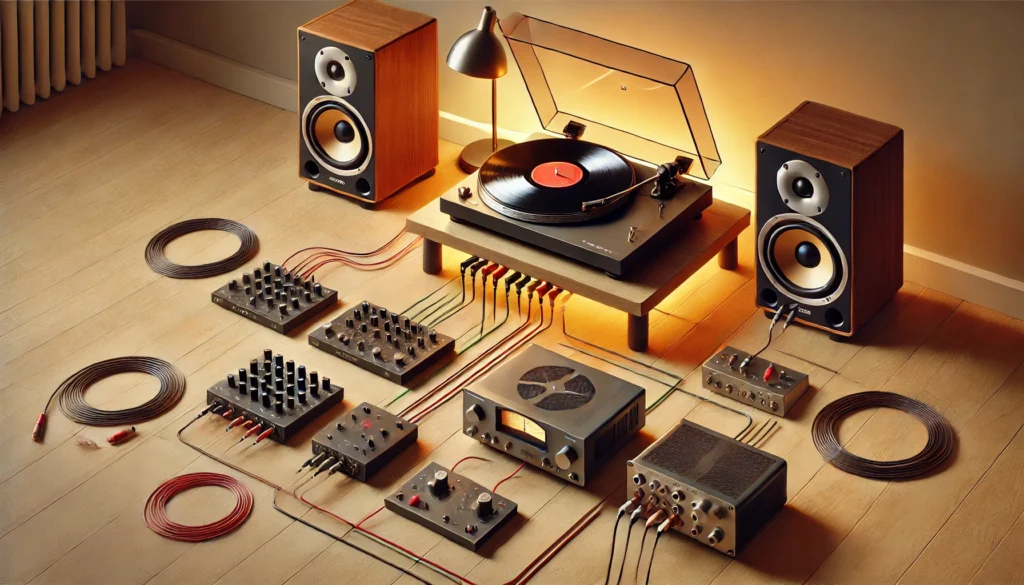
Okay, folks, let’s roll up our sleeves and talk about setting up your record player with external speakers. I know it can seem daunting at first – trust me, I’ve been there. The first time I tried to set up a full system, it looked like a tornado had hit my living room!
But don’t worry, I’m gonna break it down for you step by step, and share some of the hard-earned wisdom I’ve picked up along the way.
Step 1: Position your turntable. Find a stable, level surface away from any sources of vibration. I learned this the hard way when I put my turntable on the same shelf as my speakers – hello, feedback city!
Step 2: Connect your turntable to the phono preamp. If your turntable doesn’t have a built-in preamp, you’ll need to connect it to an external one. Just use a pair of RCA cables – red to red, white to white. Easy peasy!
Step 3: Connect the phono preamp to your amplifier. Again, use RCA cables. Connect the output of the preamp to an input on your amp – usually labeled ‘AUX’ or ‘LINE’.
Step 4: Connect your amplifier to your speakers. Use speaker wire for this. Make sure you connect the positive terminal (usually red) to positive, and negative (usually black) to negative. I once got this mixed up and couldn’t figure out why my music sounded so weird!
Step 5: Plug everything in and power it up. Double-check all your connections before you flip the switch!
Now, let’s talk troubleshooting. If you’re not getting any sound, check your connections and make sure everything’s powered on. If you hear a hum, your turntable might need to be grounded. There’s usually a little screw on the back for this.
If your sound is distorted, check your tracking force and anti-skate settings. And if one channel is quieter than the other, you might have a loose connection somewhere.
As for tips for optimal sound quality – experiment with speaker placement! I spent a whole weekend once moving my speakers inch by inch around the room until I found the sweet spot. Trust me, it makes a huge difference!
Also, make sure your turntable is properly leveled. A small bubble level can be a vinyl lover’s best friend. And don’t forget to keep your records and stylus clean – dust is the enemy of good sound!
One last tip – give your system time to warm up. I always let mine play for about 15 minutes before I sit down for some serious listening. It’s like letting a fine wine breathe, you know?
Remember, setting up a system is as much an art as it is a science. Don’t be afraid to experiment and trust your ears. After all, you’re the one who’s going to be listening to it!
Alternatives to Traditional Speakers for Record Players
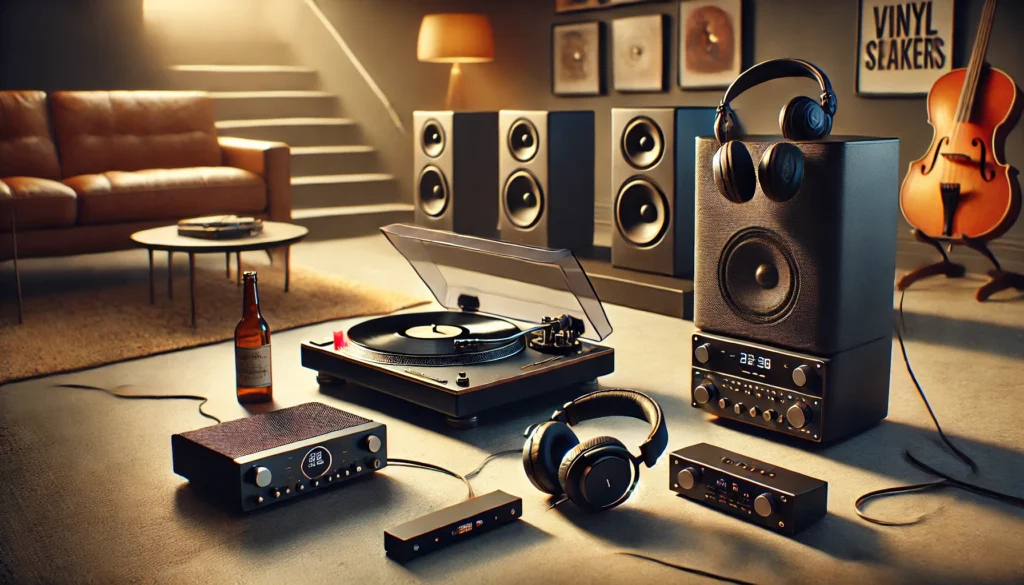
Alright, vinyl enthusiasts, let’s shake things up a bit and talk about some alternatives to traditional speakers for your record player. Because sometimes, you gotta think outside the box!
First up, let’s chat about headphones. Now, I know what you’re thinking – “Headphones? For vinyl?” But hear me out! I remember the first time I plugged a good pair of cans into my turntable setup. It was like the music was being injected straight into my brain! The detail, the intimacy – it was a whole new way of experiencing my records.
Plus, headphones are great for those late-night listening sessions when you don’t want to wake up your roommates or neighbors. Trust me, I learned that lesson the hard way after one too many noise complaints!
Next on our list: Bluetooth adapters for wireless audio. I was skeptical about this at first. I mean, isn’t the whole point of vinyl to get away from digital tech? But let me tell you, the convenience factor is off the charts! I’ve got a setup now where I can stream my turntable to wireless speakers all over my house. It’s like living in the Jetsons, but with better music!
Just keep in mind that you might lose a tiny bit of audio quality with Bluetooth. But for casual listening or background music while you’re doing chores, it’s hard to beat.
Last but not least, let’s talk about soundbars and home theater systems. Now, this might sound a bit sacrilegious to the vinyl purists out there, but hear me out. I once hooked my turntable up to my home theater system on a whim, and holy moly! The sound was huge, immersive, and it felt like the band was playing right in my living room.
It’s not for everyone, and it might not give you that pin-point stereo imaging that hardcore audiophiles crave. But if you want to feel like you’re at a concert every time you drop the needle, it’s worth a shot!
One word of caution though – make sure your home theater system has an analog input. I once spent an entire afternoon trying to figure out why I couldn’t get sound, only to realize my system was digital-only. Face, meet palm!
The beauty of all these alternatives is that they let you enjoy your vinyl in different ways and different contexts. Maybe you use traditional speakers for your serious listening sessions, headphones for late-night spins, and Bluetooth for when you’re puttering around the house.
Remember, there’s no one “right” way to listen to your records. It’s all about what works for you and your lifestyle. So don’t be afraid to experiment! Who knows? You might just discover a whole new way to fall in love with your vinyl collection all over again.
Conclusion
Whew! We’ve been on quite a journey through the world of record players and speakers, haven’t we? From built-in speakers to external setups, from traditional to alternative options, we’ve covered a lot of ground.
Here’s the thing I want you to remember: choosing the right speaker setup for your record player is a personal journey. What works for me might not work for you, and that’s okay! The most important thing is that you’re enjoying your music.
If there’s one thing I’ve learned in my years of vinyl obsession, it’s that experimentation is key. Don’t be afraid to try different setups, different speakers, even different rooms in your house. Each change can bring out new aspects of your favorite records.
And hey, if you’re just starting out, don’t feel like you need to invest in a top-of-the-line system right away. Start with what you can afford, and upgrade as you go. Trust me, half the fun is in the journey of improving your setup over time!
Remember to consider things like your living space, your budget, and your listening habits when choosing your setup. And always, always trust your ears. At the end of the day, if it sounds good to you, that’s what matters most.
Oh, and don’t forget about safety and ethical considerations. Always follow manufacturer instructions when setting up your equipment, and be mindful of your neighbors when cranking up the volume!
Now, I’d love to hear from you! What’s your current setup like? Have you tried any of the alternatives we discussed? Or maybe you’ve got a unique solution that works for you? Drop a comment below and let’s keep this vinyl conversation going!
Remember, every record collection tells a story, and every listening setup is part of that story. So go forth, spin those records, and create your own audio adventure. Happy listening, vinyl lovers!
